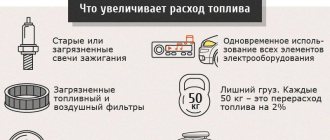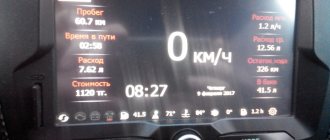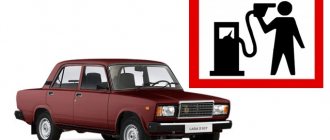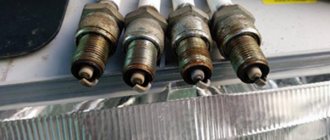Lada Largus cars are a new line of commercial vehicles produced by AvtoVAZ. They first rolled off the assembly line in 2011, and full-scale production began in 2012. The design was developed jointly with the foreign machine manufacturer Renault. The car turned out to be roomy, powerful and inexpensive, which very quickly made it popular among its compatriots.
Gasoline consumption of Lada Largus according to the passport
The passport values for gasoline consumption of the Lada Largus are determined after assembly, in factory testing laboratories. At the same time, such measurements are for informational purposes only, since the laboratory does not take into account additional influencing factors.
The table shows the fuel consumption figures for the Lada Largus, which are indicated by AvtoVAZ according to the passport. Basically, the difference in numbers is due to different engine sizes and horsepower. Fuel consumption for Lada Largus:
| Engine volume, l | Power, hp | Transmission type | Average consumption per 100 km, l | Fuel consumed |
| LADA Largus 1st generation (2012) | ||||
| 1,6 | 84 | Manual transmission | 8,1-8,6 | Unleaded gasoline AI-92 |
| 87 | Manual transmission | 8,2-8,7 | ||
| 102 | Manual transmission | 7,8-8,3 | ||
| 105 | Manual transmission | 7,8-8,4 | ||
| 106 | Manual transmission | 7,9-8,5 | ||
| LADA Largus (modification R90) | ||||
| 1.6 | 84 | Mechanical transmission | 8,1-8,8 | Unleaded fuel AI-92 |
| 87 | 8,2-8,9 | |||
| 102 | 7,8-8,6 | |||
| 105 | 7,7-8,8 | |||
| 106 | 7,9-8,9 | Gas fuel | ||
| LADA Lardus (2021 modification) | ||||
| 1,6 | 87 | Manual transmission | 8,1-8,9 | Gasoline AI-92 |
Please note that the 82 hp versions and 85 hp can not be. In fact, the passport values of gasoline consumption for the Lada Largus are provided for informational purposes only. If we compare them with real indicators, we will see that the numbers are different.
This happens because real factors such as driving style, type of road surface and fuel quality. This leads to the fact that the amount of fuel per 100 kilometers increases significantly compared to the technical passport.
Reducing fuel consumption on Lada Largus
The domestically produced station wagon Lada Largus has won the trust of the population thanks to its high-quality assembly, modern body design and practical interior. Under the hood of the family car is a time-tested power unit from Renault, which has proven itself to be a reliable and economical French engine for Largus.
The fuel consumption of a station wagon, as well as other technical characteristics, plays one of the main roles when choosing a car for a family, so this indicator requires special attention.
Initially, the domestic station wagon is equipped with two 8-valve and 16-valve petrol engines with a volume of 1.6 liters.
Differences in design with the same cylinder displacement determine the difference in power of the power units.
To objectively assess the gasoline consumption of both engine modifications, it is necessary to compare factory indicators with real reviews from owners of the Lada Largus family station wagon.
Gasoline consumption rate Lada Largus
The factory characteristics of a station wagon do not always have an objective meaning, since they are indicated on the basis of laboratory tests of the car using special roller stands. According to the passport data, both station wagon engines have the following indicators:
fuel consumption Lada Largus
Based on the comparison of power units, it can be noted that the car’s 16-valve gasoline engine significantly exceeds the dynamics of an 8-valve engine, while consuming less fuel. It is worth noting that the given values may differ depending on the quality of the fuel used.
Both engines are equipped with a 5-speed manual transmission, which has good performance in local road conditions. In addition, Largus is a copy of the famous Renault Logan and Dacia Logan, which already speaks of the quality of the transmission and all car systems as a whole.
Factors affecting the fuel consumption of Lada Largus
In a Lada Largus car, fuel consumption on two identical power units may differ slightly. This is due to the influence of the following factors:
- driving style;
- technical condition of all systems;
- quality of road surface;
- number of passengers and cargo;
- included electricity consumers, in particular air conditioning and climate control;
- routes with frequent traffic jams;
- weather;
- tuning;
- long engine warm-up;
- quality of fuel and oils used.
Engine K4M
All these factors individually increase the fuel consumption of the station wagon engine. And if the technical condition, consumable fluids and driving style can be changed, then the climatic conditions cannot be changed.
How to reduce gasoline consumption of Lada Largus?
If the owner of a domestic station wagon is not satisfied with the fuel consumption indicators, it is worth considering ways to reduce it.
First of all, it is necessary to reduce to a minimum the factors that increase fuel consumption.
The next step is to regularly maintain the car in technically sound condition, as well as comply with the rules of an economical driving style. This will help reduce excess gasoline consumption by up to 15%.
There are other ways to save fuel for Largus:
- Chip tuning of the station wagon engine reduces fuel consumption by 1.5 liters. at 100km;
- Compliance with aerodynamic rules that exclude the use of roof racks, additional body tuning and open windows when driving will provide significant fuel savings;
- Filling with high-quality gasoline recommended by the manufacturer.
By using all the presented methods, you can not only save the environment, but also achieve a reduction in the amount of gasoline consumed by up to 30%, increasing the efficiency of the station wagon's power unit.
Reviews from Lada Largus owners about real fuel consumption
An important argument influencing the real assessment of fuel consumption by a car is the reviews of the owners of a family station wagon. Who else but they knows all the pros and cons of their car. By going to forums where experienced drivers communicate, you can find a lot of useful information about the actual fuel consumption of Largus engines.
Based on real reviews, we can conclude that the Lada Largus with an 8-valve engine producing 84 hp. has a real fuel consumption of 13.5 liters in the city and 10.5 liters on the highway. 16-valve engine with 102 hp. in the urban cycle it consumes up to 11.6 liters, outside the city the consumption reaches 7.6 liters, which almost exactly coincides with the data declared by the manufacturer.
The indicators deviate slightly in one direction or another depending on the fuel used, technical condition and operating conditions. The advantage of the 16-valve engine, which has more attractive dynamics and efficiency indicators, is confirmed.
Real fuel consumption figures
Some cars are produced with 8 valves in engines. There are versions with 84 hp. and 87 hp The manufacturer promises that these cars will “eat” 10.5-10.6 liters on city streets and 6.5-6.9 liters on the highway. In reality, the values differ greatly.
For 84 hp engines. and 87 hp have approximately the same consumption in real conditions. The values are as follows:
- When driving in the city, in traffic jams and difficult traffic conditions - 12.4-13.8 l;
- If you often have to drive on the highway, between cities – 8.2-8.9 liters;
- When driving in the combined cycle - 10.1-10.9 liters.
Power plants 102 hp, 105 hp and 106 hp consume more gasoline than less powerful versions. However, the numbers are quite adequate, which contribute to fuel savings. In real conditions, the indicators are:
- Driving on city roads – 12.6-13.9 l;
- Driving on highways – 8.6-9.4 l;
- Driving both on the road and on the highway – 10.5-11.6 liters.
It must be borne in mind that consumption figures fluctuate greatly, depending on environmental conditions. In winter and at low temperatures, the specified gasoline consumption standards increase.
Those cars that are equipped with engines of 102 hp, 105 hp. and 106 hp have a basic design with 16 valves. This had a good effect on the power and dynamics of the car. Unfortunately, a negative trend towards increased gasoline consumption has emerged. For all these three engine variations, the numbers are approximately the same - we list them:
- Operating the car in the city, on a busy road – 12.5-13.6 l;
- Driving between populated areas on the highway – 8.9-9.7 l;
- Mixed operating cycle – 10.3-10.9 l.
Ways to reduce fuel consumption
To maintain low fuel consumption, you must:
- maintain speed on the highway at 85-90 km/h;
- accelerate with minimal throttle opening and early upshifts;
- reduce vehicle load;
- check the correct tire pressure (the parameter depends on the size and weight of the car);
- Carry out regular maintenance by filling with engine oil of the appropriate viscosity;
- change the air filter according to the manufacturer's recommendations;
- check the condition of the brake mechanisms and bearings in the hubs;
- fill the tank with high-quality fuel with an octane number of at least 92 units;
- reduce engine warm-up time and eliminate prolonged idling;
- do not open the side windows in the doors when driving on the highway;
- Do not install decorative elements on the car body that increase resistance to movement.
Highway consumption
In order to find out exactly how much fuel Largus consumes, it is necessary to separately evaluate consumption in urban conditions and on the highway. The second option will always have lower numbers, since driving outside the city does not require sudden acceleration and braking. Promotes reduction and movement at one, stable speed.
If we look at the reviews of car owners, the real consumption figures outside the city limits are 6.8-7.3 liters of AI-92 per 100 kilometers. If you remember the values indicated in the passport, then this parameter is indicated there as 6.3-6.7 liters. In principle, this is an insignificant difference.
Fuel consumption in urban conditions
If you mainly plan to drive along the streets of a large city, then you need to prepare for the fact that the “appetite” for gasoline will increase significantly. This will be affected by several factors:
- A driving style in which it is necessary to constantly brake sharply and pick up speed just as sharply;
- The need to stand in traffic jams;
- Parking with the engine running;
- Lower fuel quality.
If you look at the reviews of Largus owners on the Internet, they write that gasoline consumption values are 11.9-12.5 liters per 100 kilometers. Please note that if you measure this value in another vehicle, the values may differ. The reason for this is individual factors that make adjustments to the number of liters of gasoline spent per hundred. Experienced auto mechanics recommend measuring fuel readings only on an individual basis.
How to reduce fuel consumption
There are several ways to reduce Largus' appetite for gasoline. Before troubleshooting, try all of the following measures. All of them allow you to achieve a significant effect:
- Largus does not have very good aerodynamic characteristics, due to which the air flow resistance increases greatly. You can install special aerodynamic kits that will neutralize the impact of air masses. You should make accurate calculations and not buy makeshift kits;
- Fine settings thanks to chip tuning. Reflashing the electronic control unit will allow you to set precise fuel dosage settings, as well as increase the completeness of combustion of the mixture. All this will allow you to save up to 15% on gasoline;
- Refuel only at proven gas stations and do not use cheap gasoline. Savings of several hundred rubles will not cover the costs of subsequent repairs;
- Optimizing driving style and style. Avoid sudden acceleration and braking. On the highway, drive only at a stable speed of 100-110 km/h;
- Gas equipment can be installed. This will allow you to use liquefied gas for refueling, which is much cheaper than gasoline.
How to drain fuel from the system
In order to drain the fuel or change the fuel pump of the Lada Largus, you need to know the structure of the gasoline supply system. The Largus fuel system begins with the gas tank, through which we refuel the car at the gas station, and continues with main hoses to the engine inlet valves. But the gas tank cap is not the only access to the 50-liter container containing the fuel. Another tank hole is hidden under the rear seats of the car.
Having removed the rear sofa, we see a plastic cover. To remove it, you need to pry it with a screwdriver in the direction of the arrow. Under it there is a plastic lock nut with two connectors, one of which is removed using an awl, and the second by pressing on both sides. Remove the nut with a gas wrench or other wrench. In no case should you knock the nut with a chisel, this will make it difficult to install it in place.
After removing the nut we have access to the fuel pump. Then it is possible to replace the pump, fuel filter and other elements. After removing the fuel pump, direct access to the tank is created. If unsuitable fuel or foreign elements enter the gas tank, the mixture from the main tank must be drained.
How to drain gasoline from a gas tank? It is necessary to drain using a hose into a container located below the level of the gas tank (best of all - in an inspection hole). The hose should be kept at an angle to the bottom of the tank for better suction. In this way, you can drain the entire volume of the tank in a short period of time (25–30 minutes).
Owner reviews
Maxim from Lipetsk. I use Largus mainly for work - transporting small loads around the city. I like that in 3 years of operation nothing serious has broken down, the car is reliable and comfortable. My fuel consumption in the city is 12.4-12.9 liters, if I need to go to a neighboring region, then it’s less - about 9.5-9.8 liters.
Pavel from Rostov-on-Don. I bought Largus as a second car for the family. A spacious station wagon was needed to transport things to the country and home. I like the powerful engine - I have the 102 hp version. Consumption is normal - 11.8-11.9 liters in the city and 9.6-9.9 on the highway.
Timofey from Barnaul. I got a Largus 87 hp. with a mileage of 85,000 kilometers. I rebuilt the front suspension, otherwise there were practically no problems. The engine is powerful and reliable – it can even pull a loaded car. Consumption is not high, on average 10-12 liters.











